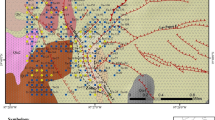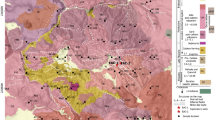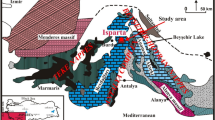Abstract
In geothermal areas, identification and distribution of hydrothermally altered rocks provide the information about the size of a geothermal system and the thermal conditions prevailing at the region. Though there are several geochemical, petrographic, and mineralogical methods successfully applied in identification of hydrothermally altered rocks, new reliable methods are simple to measure and fast are presently needed for the geothermal industry. Chemical weathering indices (CWIs), loss-on-ignition (LOI) and sulfur (S) contents, and magnetic susceptibility (χ) are some of the methods extensively and successfully applied in the studies of weathering processes and soil formation. Considering the several similarities between the weathering and hydrothermal alteration processes, the present work is carried out to evaluate whether these methods may also be successfully applied in identification of hydrothermally altered rocks in geothermal areas. The surface and subsurface rocks of Los Azufres Geothermal Field (LAGF) are considered for this purpose. The present study has indicated that the surface rocks from the LAGF are fresh/least altered as these rocks are characterized by comparatively low values (<60) of Chemical Index of Alteration (CIA), loss-on-ignition (LOI; < 2 wt%), low content of sulfur (S), and presence of several primary minerals. In the case of subsurface (well) rocks, the high values of CIA (>60) and LOI (>2 wt%) and almost absence of primary minerals throughout the depths in all the three studied wells (Az-3, Az-26 and Az-52), except in the top 500 m depth of the well Az-26, suggest that all the rocks of the three wells are altered, whereas the majority rocks in the < 500 m depth of the well Az-26 are fresh/least altered. This may be because all the three wells are characterized by same lithology (intermediate rocks), whereas acid rocks consist in the < 500 m depth in the well Az-26. This suggest that there exists a lithological influence in their values, and hence, comparison of these parameters of heterogeneous geological formations may result in erroneous conclusions. The rock samples throughout the depths in the three wells are intermediate rocks, except the rocks from < 500 m depth in the well Az-26 are acid rocks. The LOI and CIA values increase steeply in all the three wells, except in the top 500 m depth of the well Az-26, resulting into comparably higher intensity of alteration (intermediate magma). The changes in the CIA values in the top 500 m depth in the well Az-26 may be assigned to the rocks of different type (acidic rocks). Below 1000 m depths in the wells Az-3 and Az-52, the rocks are plotted very near to the boundary line differentiating fresh and altered rocks. Even in the well Az-26, the LOI values are not very high. Similarly, even though the CIA values are > 60 in the three wells (except top 500 m of the well Az-26) but not very high (mostly < 75) which indicate that the intensity of alteration has affected the alteration of the rocks in all the three wells (except top 500 m in the well Az-26) but the intensity of alteration is not very intensive. These results are in consistent with those reported in the literature for the studied samples, which says that there is a relatively low element mobility during alteration, a weak silicification, and low mobility of alkalis.
Access this chapter
Tax calculation will be finalised at checkout
Purchases are for personal use only
Similar content being viewed by others
References
Arikan F, Aydin N (2012) Influence of weathering on the engineering properties of dacites in Northeastern Turkey. International Scholarly Research Network ISRN Soil Science, vol 2012, Article ID 218527, 15 p. http://doi.org/10.5402/2012/218527
Arikawa J (1987) Sulfur contents of volcanic rocks in Japan. Bull Chem Soc Jpn 60(3):885–890
Bozkurtoğlu E, Vardar M, Suner F, Zambak C (2006) A new numerical approach to weathering and alteration in rock using a pilot area in the Tuzla geothermal area, Turkey. Eng Geol 87:33–47
Browne PRL (1970) Hydrothermal alteration as an aid in investigating geothermal fields. Geothermics (Special issue 2):564–570
Cathelineau M, Oliver R, Nieva D (1987) Geochemistry of volcanic series of the Los Azufres geothermal field (Mexico). Geofis Int 26:273–290
Duzgoren-Aydin NS, Aydin A, Malpas J (2002) Re-assessment of chemical weathering indices: case study on pyroclastic rocks of Hong Kong. Eng Geol 63:99–119
Gupta AS, Rao KS (2001) Weathering indices and their applicability for crystalline rocks. Bull Ing Geol Env 60:201–221
Hunt CP, Moskowitz BM, Banerjee SK (1985) University of Minnesota, Institute for Rock Magnetism and Department of Geology and Geophysics, 310 Pillsbury Drive SE, Minneapolis, MN 55455
Hunt CP, Moskowitz BM, Banerjee SK (1995) Magnetic properties of rocks and minerals. In: Ahrens TJ, (ed) Rock physics and phase relations: A handbook of physical constants, AGU Reference Shelf Vol 3. American Geophysical Union, Washington DC, pp 189–204. https://doi.org/10.1029/RF003p0189
Irfan TY (1994) Mechanism of creep in a volcanic Saprolite. Q J Eng Geol 27:211–230
Irfan TY (1996) Mineralogy, fabric properties and classification of weathered granitic rocks in Hong Kong. Q J Eng Geol 29:5–35
Irfan TY (1999) Characterization of weathered volcanic rocks in Hong Kong. Q J Eng Geol 32:317–348
Jayawardena UDS, Izawa E (1994a) Application of present indices of chemical weathering for Precambrian metamorphic rocks in Sri Lanka. Bull Int Ass Eng Geol 49:55–61
Jayawardena UDS, Izawa E (1994b) A new chemical index of weathering for metamorphic silicate rocks in tropical regions: a study from Sri Lanka. Eng Geol 36:303–310
Johnson WM, Maxwell JA (1981) Rock and mineral analysis, 2nd edn. Wiley, New York, 489 p
Le Bas M, Le Maitre R, Streckeisen A, Zanettin B (1986) A chemical classification of volcanic rocks based on the total alkali-silica diagram. J Petrol 7:745–750
MacKenzie DJ, Craw D (2007) Contrasting hydrothermal alteration mineralogy and geochemistry in the auriferous rise & shine Shear Zone, Otago, New Zealand. New Zeal J Geol Geophy 50:67–79
Naldrett AJ, Goodwin AM, Fisher TL, Ridler RH (1978) The sulfur content of Archean volcanic rocks and a comparison with ocean floor basalts. Cana J Earth Sci 15. http://doi.org/10.1139/e78-079
Nesbit HW, Young GM (1982) Early Proterozoic climates and plate motions inferred from major element chemistry of lutites. Nature 299:715–717
Ng CWW, Guan P, Shang YJ (2001) Weathering mechanisms and indices of igneous rocks of Hong Kong. Q J Eng Geol Hydrogeol 34:133–151
Pandarinath K (2022) Application potential of chemical weathering indices in the identification of hydrothermally altered surface volcanic rocks from geothermal fields. Geosci J (In press)
Pandarinath K, Dulski P, Torres-Alvarado IS, Verma SP (2008) Element mobility during the hydrothermal alteration of rhyolitic rocks of the Los Azufres geothermal field, Mexico. Geothermics 37:53–72
Pandarinath K, Shankar R, Alvarado IST, Warrier AK (2014) Magnetic susceptibility of volcanic rocks in geothermal areas: application potential in geothermal exploration studies for identification of rocks and zones of hydrothermal alteration. Arab J Geosci 7:2851–2860
Pandarinath K, Shankar R, Santoyo E, Shwetha S, García-Soto A, Gonzalez-Partida E (2019) A rock magnetic fingerprint of hydrothermal alteration in volcanic rocks—an example from the Los Azufres Geothermal Field, Mexico. J South Am Earth Sci 91:260–271
Peck DL, Griggs AB, Schlicker HG, Wells FG, Dole HM (1964) Geology of the central and northern parts of the Western Cascade Range in Oregon. USGS professional paper 449, pp 1–62
Reed MH, Spycher N (1984) Calculation of pH and mineral equilibria in hydrothermanl waters with application to geothermometry and studies of boiling and dilution. Geochim Cosmochim Acta 48:1479–1492
Reiche P (1943) Graphic representation of chemical weathering. J Sediment Petrol 13:58–68
Ruxton BP (1968) Measures of the degree of chemical weathering of rocks. J Geol 76:518–527
Schulte EE, Kaufmann C, Peter JB (1991) The influence of sample size and heating time on soil weight loss-on-ignition. Commun Soil Sci Plant Anal 22:159–168
Selby MJ (1993) Hillslope materials and processes. Oxford University Press, Oxford, 480 p
Sprenger M, Tetzlaff D, Soulsb C (2017) Soil water stable isotopes reveal evaporation dynamics at the soil–plant–atmosphere interface of the critical zone. Hydrol Earth Syst Sci 21:3839–3858
Sueoka T, Lee K, Huramatsu M, Imamura S (1985) Geomechanical properties and engineering classification for decomposed granite soils in Kaduna District, Nigeria. In: Proceedings of the first international conference on geomechanics in tropical lateritic and saprolitic soils, Brasilia, vol 1, pp 175–186
Thompson R, Oldfield F (1986) Environmental magnetism. Allen & Unwin; Springer, London
Torres-Alvarado IS (1996) Azufres, Mexiko: Mineralogische, thermochemische und isotopengeochemische Untersuchungen. Tübinger Geowissenschaftliche Arbeiten, Reihe (Band 2), 181 p
Torres-Alvarado IS, Satir M (1998) Geochemistry of hydrothermally altered rocks from Los Azufres geothermal field, Mexico. Geofis Int 37:201–213
Vassallo LF, Aranda-Gómez JJ, Solorio-Munguía JG (2015) Hydrothermal alteration of volcanic rocks hosting the Late Jurassic-Early Cretaceous San Nicolás VMS deposit, southern Zacatecas, Mexico. Revista Mexicana de Ciencias Geológicas 32:254–272
Verma SP, Rivera-Gomez A (2017) Transformed major element based multidimensional classification of altered volcanic rocks. Episodes 40(4):295–303
Verma SP, Rivera-Gómez MA, Díaz-González L, Pandarinath K, Amezcua-Valdez A, Rosales-Rivera M, Verma SK, Quiroz-Ruiz A, Armstrong-Altrin JS (2017). Multidimensional classification of magma types for altered igneous rocks and application to their tectonomagmatic discrimination and igneous provenance of siliciclastic sediments. Lithos 278-281:321–330
Verma SP, Pandarinath K, Bhutani R, Das JK (2018) Mineralogical, chemical, and Sr-Nd isotopic effects of hydrothermal alteration of near-surface rhyolite in the Los Azufres geothermal field, Mexico. Lithos 322:347–361
Wani SA, Najar GR, Ali T, Akhtar F (2016) Morphology, genesis and classification of pear growing soils of Pulwama district in Lesser Himalayas of temperate Kashmir. J Environ Biol 37:1021–1027
Author information
Authors and Affiliations
Corresponding author
Editor information
Editors and Affiliations
Rights and permissions
Copyright information
© 2022 The Author(s), under exclusive license to Springer Nature Singapore Pte Ltd.
About this chapter
Cite this chapter
Pandarinath, K. (2022). Impacts of Hydrothermal Alteration on Magnetic Susceptibility and Some Geochemical Properties of Volcanic Rocks from Geothermal Areas. In: Armstrong-Altrin, J.S., Pandarinath, K., Verma, S.K. (eds) Geochemical Treasures and Petrogenetic Processes. Springer, Singapore. https://doi.org/10.1007/978-981-19-4782-7_16
Download citation
DOI: https://doi.org/10.1007/978-981-19-4782-7_16
Published:
Publisher Name: Springer, Singapore
Print ISBN: 978-981-19-4781-0
Online ISBN: 978-981-19-4782-7
eBook Packages: Earth and Environmental ScienceEarth and Environmental Science (R0)




